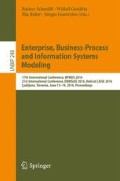Abstract
Enterprises have a large amount of Information Technology (IT) elements for supporting their business. Enterprise models represent the state of IT and business elements and the relation between them in a certain moment. However, in some cases it is difficult to build models that accurately represent the enterprise because information may vary fast over time, or because the granularity of the model may be inadequate for its purpose. When models that are imprecise and do not represent accurately the enterprise are used to perform analysis, it is necessary to evaluate their suitability and determine whether they can be used or if better models have to be constructed. In this paper, we focus on this problem and propose an approach for evaluating the level of imprecision of enterprise models based on the impact and sensitivity of imprecise information regarding an analysis method.
Access this chapter
Tax calculation will be finalised at checkout
Purchases are for personal use only
References
Jonkers, H., Lankhorst, M., Van Buuren, R., Hoppenbrouwers, S., Bonsangue, M., Van Der Torre, L.: Concepts for modeling enterprise architectures. Int. J. Coop. Inf. Syst. 13(03), 257–287 (2004)
Bézivin, J.: On the unification power of models. Softw. Syst. Model. 4(2), 171–188 (2005)
Ludewig, J.: Models in software engineering–an introduction. Softw. Syst. Model. 2(1), 5–14 (2003)
Lankhorst, M.: Enterprise architecture at work: Modelling, communication and analysis. Springer, Heidelberg (2013)
Lagerström, R., Franke, U., Johnson, P., Ullberg, J.: A method for creating enterprise architecture metamodels-applied to systems modifiability analysis. Int. J. Comput. Sci. Appl. 6(5), 89–120 (2009)
Kurpjuweit, S., Winter, R.: Viewpoint-based Meta Model Engineering. In: Proceedings of the 2nd International Workshop on Enterprise Modelling and Information Systems Architectures, pp. 143–161 (2007)
Frank, U.: Multi-perspective enterprise modeling: foundational concepts, prospects and future research challenges. Softw. Syst. Model. 13(3), 941–962 (2014)
Avila, O., Goepp, V., Kiefer, F.: Understanding and classifying information system alignment approaches. J. Comput. Inf. Syst. 50(1), 2–14 (2009)
Henricksen, K., Indulska, J.: Modelling and using imperfect context information. In: Proceedings of the Second IEEE Annual Conference on Pervasive Computing and Communications Workshops, 2004, pp. 33–37. IEEE (2004)
Buckl, S., Matthes, F., Schweda, C.M.: Classifying enterprise architecture analysis approaches. In: Poler, R., van Sinderen, M., Sanchis, R. (eds.) IWEI 2009. LNBIP, vol. 38, pp. 66–79. Springer, Heidelberg (2009)
Florez, H., Sanchez, M., Villalobos, J.: A catalog of automated analysis methods for enterprise models. SpringerPlus 5, 1–24 (2016)
Holschke, O.: Impact of granularity on adjustment behavior in adaptive reuse of business process models. In: Hull, R., Mendling, J., Tai, S. (eds.) BPM 2010. LNCS, vol. 6336, pp. 112–127. Springer, Heidelberg (2010)
Florez, H., Sanchez, M., Villalobos, J.: iArchiMate: a tool for managing imperfection in enterprise models. In: 18th IEEE International Enterprise Distributed Object Computing Conference Workshops and Demonstrations (EDOCW), pp. 201–210. IEEE (2014)
Johnson, P., Johansson, E., Sommestad, T., Ullberg, J.: A tool for enterprise architecture analysis. In: 11th IEEE International Enterprise Distributed Object Computing Conference (EDOC 2007), pp. 142–142. IEEE, October 2007
Florez, H., Sanchez, M., Villalobos, J.: Extensible model-based approach for supporting automatic enterprise analysis. In: 18th IEEE International Enterprise Distributed Object Computing Conference (EDOC), pp. 32–41 (2014)
Morrissey, J.M.: Imprecise information and uncertainty in information systems. ACM Trans. Inf. Syst. (TOIS) 8(2), 159–180 (1990)
Loshin, D.: The practitioner’s guide to data quality improvement. Elsevier, Amsterdam (2010)
Author information
Authors and Affiliations
Corresponding author
Editor information
Editors and Affiliations
Rights and permissions
Copyright information
© 2016 Springer International Publishing Switzerland
About this paper
Cite this paper
Florez, H., Sánchez, M., Villalobos, J. (2016). Analysis of Imprecise Enterprise Models. In: Schmidt, R., Guédria, W., Bider, I., Guerreiro, S. (eds) Enterprise, Business-Process and Information Systems Modeling. BPMDS EMMSAD 2016 2016. Lecture Notes in Business Information Processing, vol 248. Springer, Cham. https://doi.org/10.1007/978-3-319-39429-9_22
Download citation
DOI: https://doi.org/10.1007/978-3-319-39429-9_22
Published:
Publisher Name: Springer, Cham
Print ISBN: 978-3-319-39428-2
Online ISBN: 978-3-319-39429-9
eBook Packages: Business and ManagementBusiness and Management (R0)

